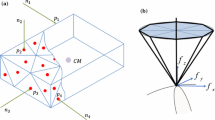Abstract
This paper presents an approach for grasp planning and grasp forces optimization of polygon shaped objects. The proposed approach is an intelligent rule-based method that figures out the minimal number of fingers and minimal values of contact forces. These fingers are required to securely grasp a rigid body in the presence of friction and under the action of some external force. This is accomplished by finding optimal contact points on the object boundary along with minimal number of fingers required for achieving the aforementioned goal. Our system handles every object case independently. It generates a rule base for each object based on adequate values of external forces. The system uses the genetic algorithm as its search mechanism, and a rule evaluation mechanism called bucket brigade for the reinforcement learning of the rules. The process mainly consists of two stages; learning then retrieval. Retrievals act on line utilizing previous knowledge and experience embedded in a rule base. If retrievals fail in some cases, learning is presumed until that case is resolved. The algorithm is very general and can be adapted for interface with any object shape. The resulting rule base varies in size according to the degree of difficulty and dimensionality of the grasping problem.
Similar content being viewed by others
References
Tung, Chao-ping and Kak, Avinash C.: Fast construction of force-closure grasps, IEEE Trans. Robotics Automat. 12(4) (1996), 615-626.
Mangialardi, L., Montriota, G., and Trientadue, A.: A three-dimensional criterion for the determination of optimal grip points, Robotics and Computer-Integrated Manufacturing 12(2) (1996), 157-167.
Nguyen, Van-Duc: Constructing force-closure grasps, Proc. IEEE Robotics Automation Conference, Vol. III, 1986, pp. 1368-1373.
Markenscoff, X. and Papadimitriou, C. H.: Optimum grip of a polygon, Int. J. Robotics Res. 8(2) (1989), 17-29.
Bicchi, A.: On the closure properties of robotic grasping, Int. J. Robotics Res. 14(4) (1992), 319-334.
Al-Fahed, A. M., Stavroulakis, G. E., and Panagiotopoulos, P. D.: A linear complementarity approach to the frictionless gripper problem, Int. J. Robotics Res. 11(2) (1992), 112-122.
Al-Fahed Nuseirat, A. M., Hamdan, A. M. A., and Hamdan, H. M. A.: Stability and modal control of an object grasped by a multifingered robot hand, Z. angew. Math. Mech. 79(7) (1999), 473-479.
Panagiotopoulos, P. D. and Al-Fahed, A. M.: Robot hand grasping and related problems: Optimal control and identification, Int. J. Robotics Res. 13(2) (1994), 127-136.
Stavroulakis, G. E., Goeleven, D., and Panagiotopoulos, P. D.: New models for a class of adhesive grippers. The hemivariational inequality approach, Arch. Appl. Mech. 67 (1996), 50-61.
Liu, Y.-H.: Qualitative test and force optimization of 3-D frictional form closure grasps using linear programming, IEEE Trans. Robotics Automat. 15(1) (1999), 163-173.
Abu-Zitar, R. and Al-Fahed Nuseirat, A. M.: A neural network approach to the frictionless grasping problem, J. Intelligent and Robotic Systems 29(1) (2000), 27-45.
Nguyen, V.-D.: Constructing force-closure grasps, Int. J. Robotics Res. 7(3) (1989), 3-16.
Fogel, D. B.: System Identification through Simulated Evolution: A Machine Learning Approach to Modeling, Ginn Press, Needham, MA, 1991.
Goldberg, D. E.: Genetic Algorithms in Search Optimization, and Machine Learning, Addison-Wesley, Reading, MA, 1989.
Widrow, B. and Nguyen, D.: The truck backer-upper: An example of self learning in neural networks, in: Proc. of the Internat. Joint Conf. on Neural Networks, Vol. 2, Washington, DC, June 1989, pp. II357-363.
Abu Zitar, R. A. and Hassoun, M. H.: Neurocontrollers trained with rules extracted by a genetic assisted reinforcement learning system, IEEE Trans. Neural Networks 6(4) (1995), 859-879.
Abu Zitar R. A. and Hassoun, M. H.: Regulator control via genetic assisted reinforcement learning, in: Proc. of the Fifth Internat. Conf. on Genetic Algorithms, Urbana-Champaign Illinois, 1993, pp. 251-260.
Abu Zitar, R. A.: Machine Learning with Rule Extraction by Genetic Assisted Reinforcement( REGAR): Application to Nonlinear Control, Ph.D. dissertation, Department of Electrical and Computer Engineering, Wayne State University, Detroit, MI, 1993.
Davis, L.: Adapting operator probabilities in genetic algorithms, in: J. D. Schaffer (ed.), Proc. of the Third International Conference on Genetic Algorithms, Morgan Faufmann, San Mateo, CA, 1989.
Fletcher, R.: Practical Methods of Optimization, Wiley, New York, 1987.
Montana, D. J.: Contact stability for two-fingered grasps, IEEE Trans. Robotics Automat. 8(4) (1992), 421-430.
Booker, L. B., Goldberg, D. E., and Holland J. H.: Classifier systems and genetic algorithms, Artificial Intelligence 40 (1989), 235-282.
Davis, L.: Adapting operator probabilities in genetic algorithms, in: Proc. of the Third Internat. Conf. on Genetic Algorithms, 1989, pp. 60-69.
Booker, L. B.: Improving the performance of genetic algorithms in classifier systems, in: Proc. of the First Internat. Conf. on Genetic Algorithms and their Applications, Pittsburg, PA, 1985, pp. 80-92.
Holland, J. H.: A mathematical framework for studying learning in classifier systems, Physica D 22 (1986), 307-317.
Davis, L.: Handbook of Genetic Algorithms, Van Nostrad, Reinhold, New York, 1991.
Hinton, G. E. and Nowlan, S. J.: How learning can guide evolution, Complex Systems 1 (1997), 495-502.
Holland, J. H.: Adaptation in Natural and Artificial Systems, University ofMichigan Press, Ann Arbor, MI, 1975.
Sutton, R. S.: Learning to predict by methods of temporal differences, Machine Learning 3 (1988), 9-41.
Wilson, S.W.: Classifier systems and the ANIMAT problem, Machine Learning 2 (1987), 199-228.
Abu Zitar, R. A. and Hassoun, M. H.: Genetic and reinforcement-based rule extraction for regulator control, in: Proc. of the 32nd IEEE Conf. on Decision and Control, San Antonio, Texas, 1993.
Author information
Authors and Affiliations
Rights and permissions
About this article
Cite this article
Abu-Zitar, R., Al-Fahed Nuseirat, A.M. A Theoretical Approach of an Intelligent Robot Gripper to Grasp Polygon Shaped Objects. Journal of Intelligent and Robotic Systems 31, 397–422 (2001). https://doi.org/10.1023/A:1012094400369
Issue Date:
DOI: https://doi.org/10.1023/A:1012094400369




